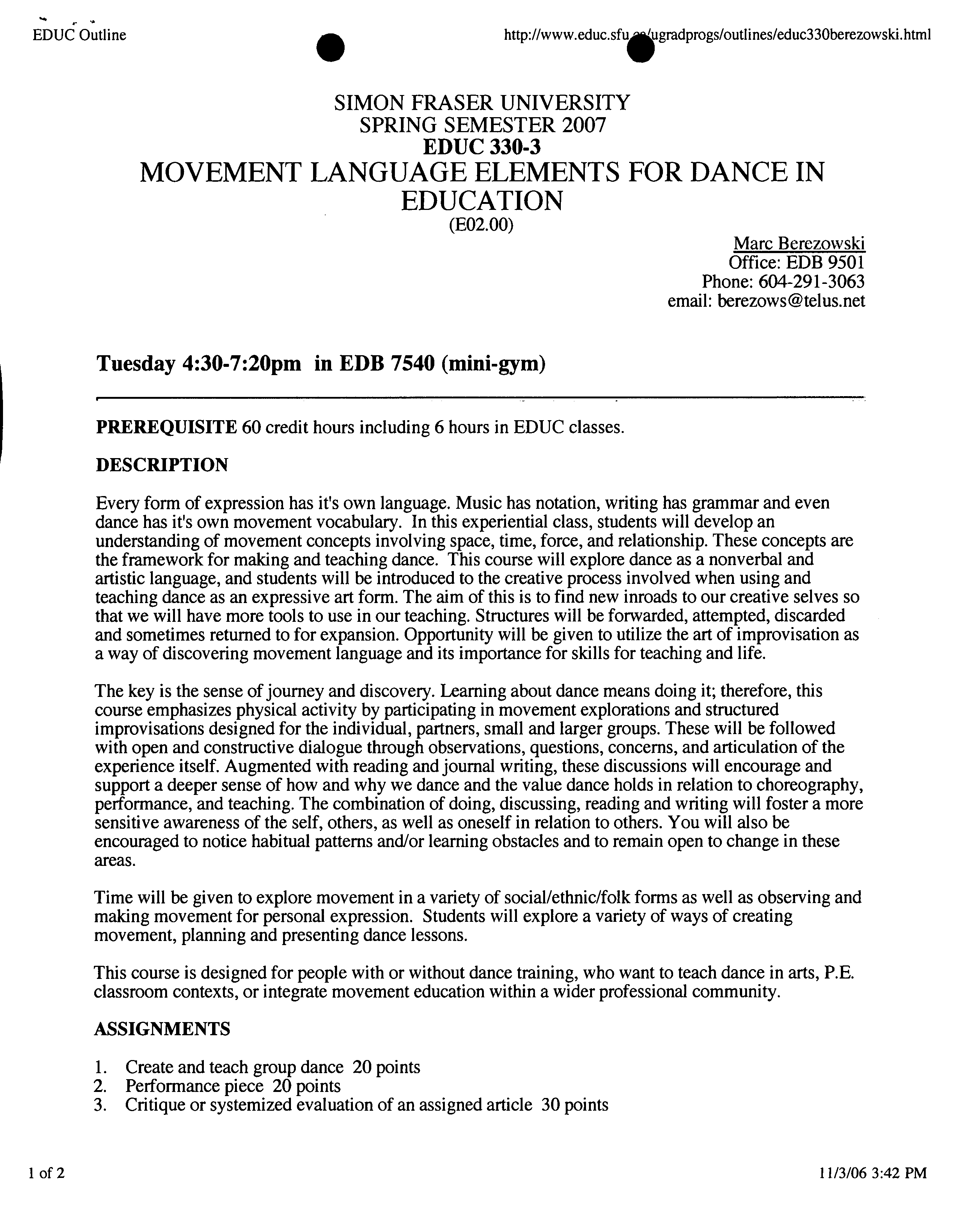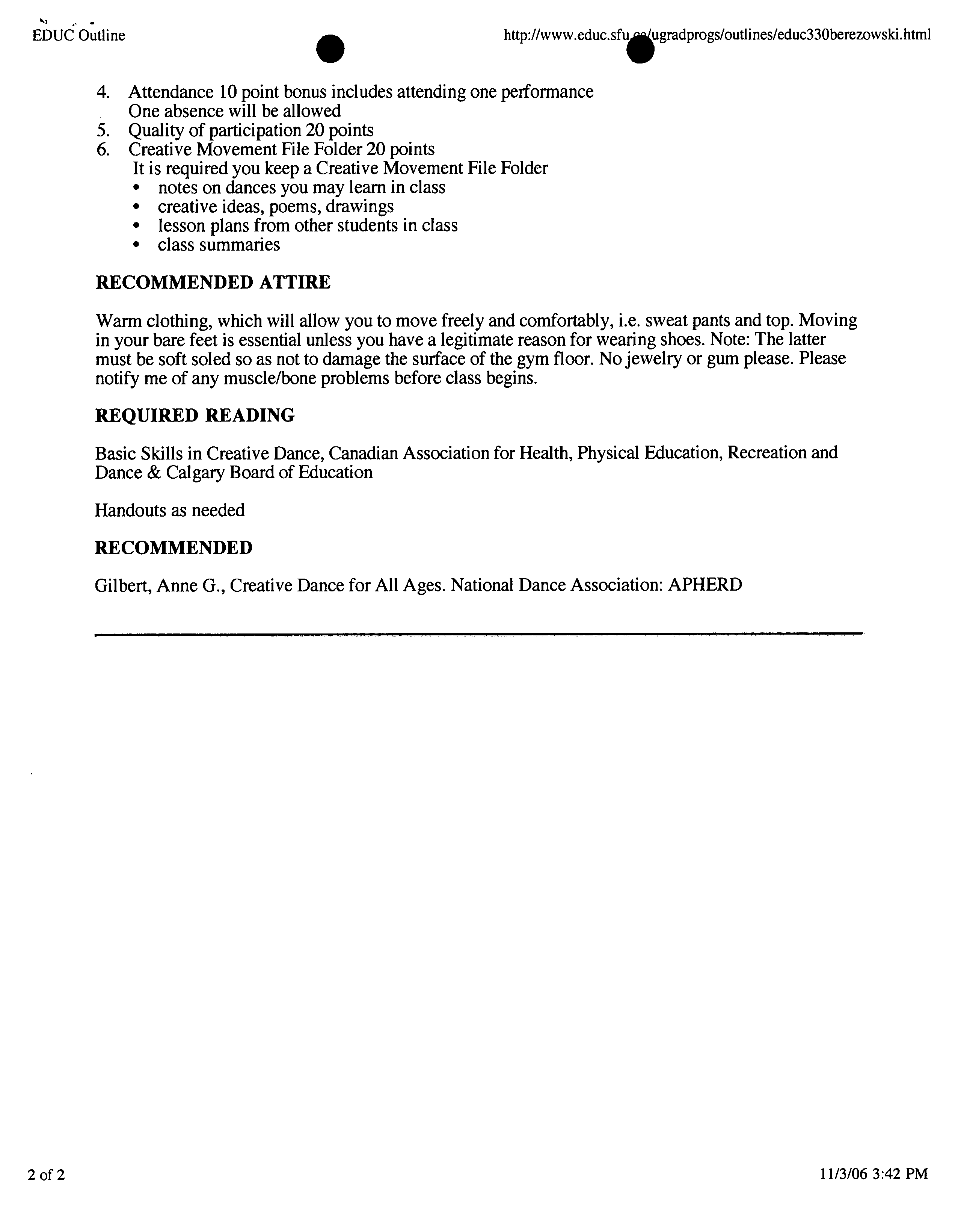EDUC Outline
http://www.educ.sfu
'ugradprogs/outlines/educ33Oberezowski.html
SIMON FRASER UNIVERSITY?
SPRING SEMESTER 2007?
EDUC 330-3
MOVEMENT LANGUAGE ELEMENTS FOR DANCE IN ?
EDUCATION
(E02.00)
Marc Berezowski ?
Office: EDB 9501
?
Phone: 604-291-3063?
email: berezows@telus.net
Tuesday 4:30-7:20pm in EDB
7540
(mini-gym)
PREREQUISITE
60 credit hours including 6 hours in EDUC classes.
DESCRIPTION
Every form of expression has it's own language. Music has notation, writing has grammar and even
dance has it's own movement vocabulary. In this experiential class, students will develop an
understanding of movement concepts involving space, time, force, and relationship. These concepts are
the framework for making and teaching dance. This course will explore dance as a nonverbal and
artistic language, and students will be introduced to the creative process involved when using and
teaching dance as an expressive art form. The aim of this is to find new inroads to our creative selves so
that we will have more tools to use in our teaching. Structures will be forwarded, attempted, discarded
and sometimes returned to for expansion. Opportunity will be given to utilize the art of improvisation as
a way of discovering movement language and its importance for skills for teaching and life.
The key is the sense of journey and discovery. Learning about dance means doing it; therefore, this
course emphasizes physical activity by participating in movement explorations and structured
improvisations designed for the individual, partners, small and larger groups. These will be followed
with open and constructive dialogue through observations, questions, concerns, and articulation of the
experience itself. Augmented with reading and journal writing, these discussions will encourage and
support a deeper sense of how and why we dance and the value dance holds in relation to choreography,
performance, and teaching. The combination of doing, discussing, reading and writing will foster a more
sensitive awareness of the self, others, as well as oneself in relation to others. You will also be
encouraged to notice habitual patterns and/or learning obstacles and to remain open to change in these
areas.
Time will be given to explore movement in a variety of social/ethnic/folk forms as well as observing and
making movement for personal expression. Students will explore a variety of ways of creating
movement, planning and presenting dance lessons.
This course is designed for people with or without dance training, who want to teach dance in arts, P.E.
classroom contexts, or integrate movement education within a wider professional community.
ASSIGNMENTS
1.
Create and teach group dance 20 points
2.
Performance piece 20 points
3.
Critique or systemized evaluation of an assigned article 30 points
1 of 2 ?
11/3/06 3:42 PM
¼)
EDUC Outline
http://www.educ.sfu
ugradprogs/outlines/educ33Oberezowski.html
4.
Attendance 10 point bonus includes attending one performance
One absence will be allowed
5.
Quality of participation 20 points
6.
Creative Movement File Folder 20 points
It is required you keep a Creative Movement File Folder
• notes on dances you may learn in class
• creative ideas, poems, drawings
• lesson plans from other students in class
• class summaries
RECOMMENDED ATTIRE
Warm clothing, which will allow you to move freely and comfortably, i.e. sweat pants and top. Moving
in your bare feet is essential unless you have a legitimate reason for wearing shoes. Note: The latter
must be soft soled so as not to damage the surface of the gym floor. No jewelry or gum please. Please
notify me of any muscle/bone problems before class begins.
REQUIRED READING
Basic Skills in Creative Dance, Canadian Association for Health, Physical Education, Recreation and
Dance & Calgary Board of Education
Handouts as needed
RECOMMENDED
Gilbert, Anne G., Creative Dance for All Ages. National Dance Association: APHERD
2of2 ?
11/3/06 3:42 PM


